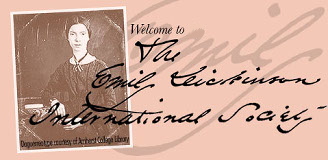You are here
Miller, Cristanne: "Genetic Editing: The Challenges and “Possibility” of a New Print Edition of Dickinson’s Poems"
Submitted by cmiller on July 19, 2013 - 10:58am
Genetic Editing: The Challenges and “Possibility” of a New Print Edition of Dickinson’s Poems
Cristanne Miller, University at Buffalo, SUNY
While electronic online sites presenting images of Dickinson's manuscripts proliferate, I am preparing a print readers edition of Dickinson's complete poems. Print inevitably imposes limits on what can be done but also allows for focused attention to information less obvious in larger, more complete, and more complex presentations. In particular, this will be a genetic edition of the poems, meaning that it will focus on a particular moment in her process of writing and circulating poems, in hopes that focus on that moment will both make readers conscious that Dickinson apparently saw her writing as a process and stimulate new thinking about her composition and use of poetry.
To the extent possible, the moment of focus for this edition is the one in which she makes a copy of any given poem to retain for herself. Dickinson's work always raises complexities, and this point of focus faces a number. While Dickinson made clean (or what I regard as clean) copies of the great majority of her poems, she left many in a less finished state and furthermore apparently kept no copies at all of some poems. Others she did keep but the manuscripts have been lost so we have access to them only through transcripts. Because this is both a “complete” poems and a readers edition, I will include just one copy of each poem—regardless of how many copies Dickinson retained among her papers, unless, that is, she copies a poem more than once into a fascicle, in which case I will include it twice—in each case where and exactly how she presents it. The Table of Contents of the volume [slide] will distinguish poems she retained from those she did not and from those extant only in transcription. The volume will also follow an order that leads from most cleanly copied and preserved poems to those she (to our knowledge) never kept at all, starting with her fascicle booklet poems in the order they are written and bound and then the poems she copied onto bifolium sheets (what Franklin called “sets”).
For each copied poem, I will include all alternatives she writes onto the manuscript page at or about the time she is first copying the poem. Because this is a genetic edition, I will not show later (or earlier) variations of the poems she circulated (although I will note for every poem whether or not the poem was circulated, to whom, the date, and whether the circulated poem was variant). I will also not show revisions made on the manuscript page if it seems clear that she made those revisions at a different point in time. Again, my interest is in the moment in which she copies out a poem to retain, not in the sum total of variations to its text or in a visual representation of the manuscript page: as of this fall, there will be a plethora of sites one can visit to see the image of every poetry manuscript, and many others besides—thanks to projects like those of my fellow panelists. Moreover, this edition will be annotated. Notes at the end will include brief information about Dickinson’s practices of quotation and allusion and pertinent biographical information.
The remainder of my brief presentation will give a few examples of what pages in my edition may look like and then speculate on how a genetic print presentation of the poems may stimulate new thinking about Dickinson’s poetry.
|

